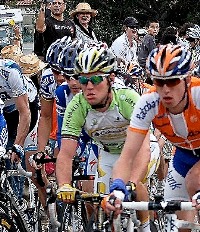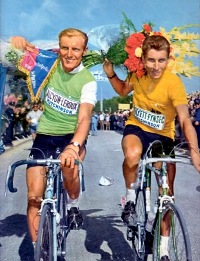Men of Man
Twenty five years before Manxman Mark Cavendish was born, the world’s elite professional cyclists were on the Isle of Man racing the highly prestigious Manx Premier Pro Road Race. In 1960 the race was won by the then World Road Race Champion André Darrigade from a four man breakaway.
 Mark Cavendish in the peloton
Mark Cavendish in the peloton
[photos from CyclingRevealed] |
The Isle of Man Cycling Festival (a week long event) originated in 1936 but sadly ended with the 2003 edition. Each year the Manx cycling week represented a major highlight of the British cycling calendar. The pro race attracted the cream of the European elite peloton and was viewed as a highly prestigious victory. The Manx Pro race used the fabled Isle of Man motorcycle TT course which included the five mile climb up Snaefell. Unlike most races on mainland Europe, a feature much appreciated by the professionals was the post race banquet. Such hospitality did not exist at most of the famous European races. But apart from the banquet and the huge throngs of highly knowledgeable club cyclists drawn to the big event, it was the timing of the race that appealed to the riders. Coming just days before the start of the Tour de France, the highly challenging circuit was viewed as a perfect way to hone Tour fitness.
From 1956 to 1970 the event experienced its golden years attracting amongst others Fausto Coppi, Jacques Anquetil, Raymond Poulidor, Rudi Altig, Tom Simpson, Barry Hoban, Eddy Merckx and 1960 race winner André Darrigade.
The Isle of Man is just 32 miles long and 14 miles wide and is located in the Irish Sea. It is a rugged place with inhabitants going back to Neolithic times (about 6500BC). Founded in AD 979, the Tynwald is said to be the oldest continuous parliament in the world. Mark Cavendish is not the first successful sports person to come from the island but he is well on his way to becoming the most highly decorated.
Today Mark Cavendish is widely recognised as the best road sprinter of the current generation. Many are predicting that in time he will be remembered as the best sprinter of all time. Originally a track rider, Cavendish transitioned from track racing to the road in 2006 and became a pro in 2007. In just three seasons he has amassed over 50 road wins. But while many observers measure quantity, it is the quality of his victories which astound. In his rookie pro year he abandoned the Tour but finished the year equalling Alessandro Petacchi’s neo-pro record of 11 victories. While this was a highly notable feat it was the 2008 season where he started to forge his reputation. Two stage wins at the Giro and an incredible four stage wins at the Tour de France (the first British cyclist to achieve this), and all at the tender age of 22. In his third season (2009) he amassed 26 victories: six Tour de France stages, three Giro d’Italia stages (four counting the team time trial victory) and a ‘Monument’ win at the early season Milan-San Remo are highlights from a magical year.
 Andre Darrigade and Jacque Anquetil
Andre Darrigade and Jacque Anquetil
[photos from Archive] |
Comparing riders across generations is very difficult but the name that is often viewed as a benchmark for Cavendish to surpass is André Darrigade. This great road sprinter raced as a pro from 1951 to 1964. He holds the record for Tour de France stage wins with 22 victories (excluding prologues and ITT’s) and during his career he wore the Yellow Jersey for 16 days. He claimed the TdF Green Jersey twice, won the World RR Championship in 1959 and added a ‘Monument’ (the Giro di Lombardia) in 1956.
Darrigade, a heavily built man, was renowned for fast, spectacular sprint finishes. However in his time the concept of the lead-out train as we now know it had not been developed. Teammates would help set up the sprint but finishes were then largely managed by the individual stars. Although he was a big star in his own right, Darrigade always professed to be a team man. Unlike today’s sprint specialists, Darrigade often slipped into race winning breaks. In this situation he was usually in control as he mercilessly drove his companions towards the finish line where they had little chance of beating him. Such was the case with his 1960 Manx Pro RR victory.
While Darrigade has both the number of victories and the reputation to place him high on the list of exceptional road sprinters, there are other names that also command awe and respect: Mario Cipollini (The Lion King) with 191 career victories, he perfected the concept of the lead-out train. He holds the record for Giro d’Italia stage wins at 42. He was World RR Champion in 2002 and like Cavendish has a Milan-San Remo victory to his name.
 Djamolidine Abdoujaparov's famous crash
Djamolidine Abdoujaparov's famous crash
[photos from Archive] |
Djamolidine Abdoujaparov (The Tashkent Terror) is remembered for his ferociously wild and erratic sprints that were known to have caused many crashes. He won the Green Points Jersey at all three Grand Tours (three times at the TdF).
Freddy Maertens with 219 pro career victories is considered by many as the greatest road sprinter of all time. In fact both Sean Kelly (who also ranks as one of the best road sprinters ever) and Mario Cipollini have stated that if all the past great sprinters were to come up against Cavendish it would only be Maertens who could truly challenge him.
Eric Zabel recently retired, claimed over 200 road victories in a long and illustrious career. While a lot less flamboyant than Maertens, Abdoujaparov and Cipollini, the quiet East Berliner was a greatly feared sprinter. He claimed nine Grand Tour Green Points Jersey’s (6 TdF, 3 Vuelta) and won several major classics including four victories at the Milan-San Remo. Currently Zabel is employed by Cavendish’s team as a race advisor. Who better than Zabel to guide Cavendish to his victories?
The key to Cavendish’s success lies in his phenomenal acceleration at the end of a race. As Cipollini explained, when he was brought to the finishing stretch by his lead-out train, he could maintain the momentum to the line. At that point the speed was so high that nobody could get past him. With Cavendish his gift is that when he makes his final move he not only maintains his lead-out train velocity but then increases his speed right up to the line. It is this final burst of acceleration that kills his opponents.
 Freddy Maertens
Freddy Maertens |
 Erik Zabel
Erik Zabel |
 Mario Cipollini
Mario Cipollini |
But if Cavendish is to surpass the greats of the past he will need more than the ability to suck wheels and then simply explode over the final couple of hundred meters or so. To this end Cavendish has already illustrated the hallmark of a great champion with his astounding 2009 Milan-San Remo victory. All the experts predicted that while a win here may lie in Cavendish’s future, he was, at age 23, too young and inexperienced to win this edition of the ‘Monument’. In particular most experts stated that the final two hills of the race would simply dispatch the young sprinter out of the back of the peloton. On the day Cavendish managed to stay with the large lead group up and over the Cippresa climb and then ‘hung on for dear life’ over the fabled Poggio climb. Over the top of this final obstacle he found his teammate George Hincapie who then guided him through the bunch and on to the streets of San Remo. Into the final kilometer Cervelo’s Heinrich Haussler made a bold bid for victory with a surprise attack. By the time the other sprinters had organised their wits Haussler looked to have the win. But Cavendish thought otherwise and put it into overdrive. With just 100 meters to go Cavendish was still 10 meters back but his killer acceleration enabled him to take the race by the slimmest of margins from Haussler.
At his Milan-San Remo post race press conference Cavendish said, "I wanted to prove I am more than just a sprinter, but a great rider – that is what I did today." The young rider has a long way to go to emulate the likes of Darrigade, Maertens, Cipollini and Zabel. However if Cavendish fulfils his demonstrated potential and continues to rack up Grand Tour stage wins, claim a World RR Championship and more classics, then it will be a case of wonderful historical symmetry. André Darrigade made several pilgrimages to the Isle of Man and now with that island’s favourite son creating a new legacy, both riders can be said to be Men of Man.
Return to ToC >>> |
